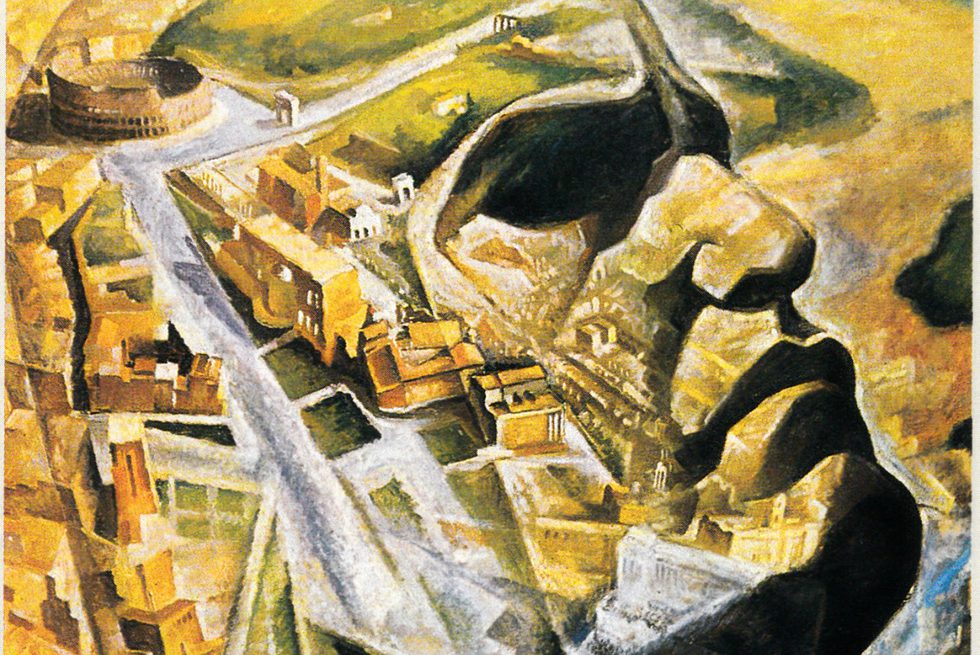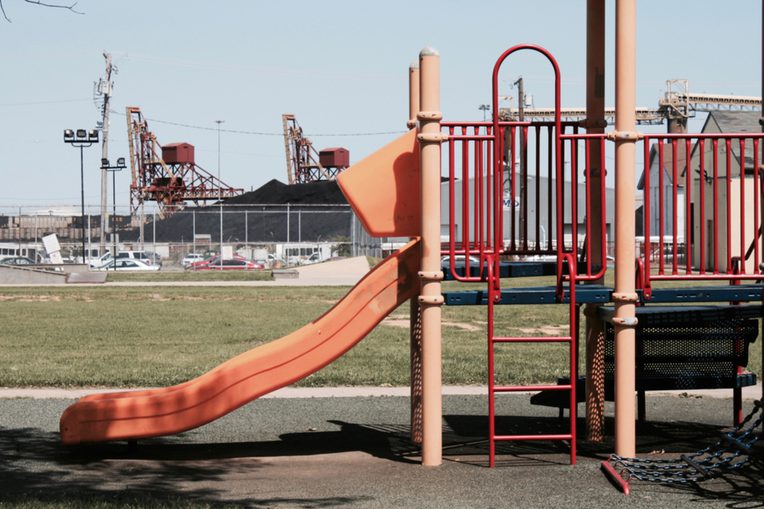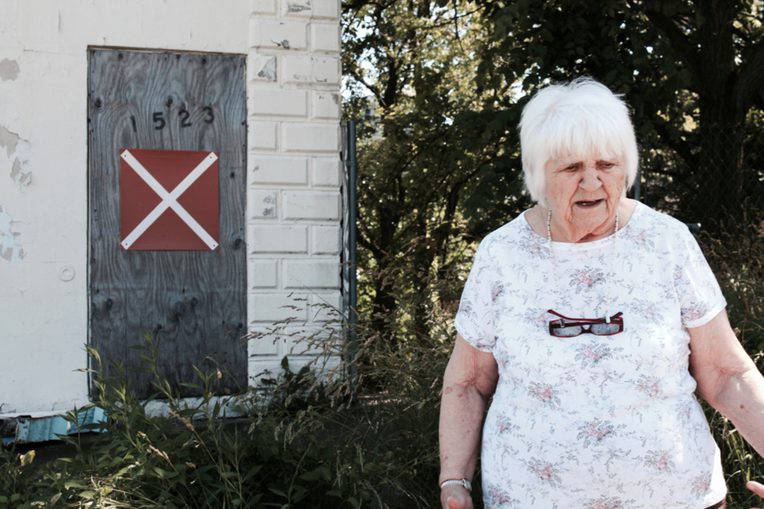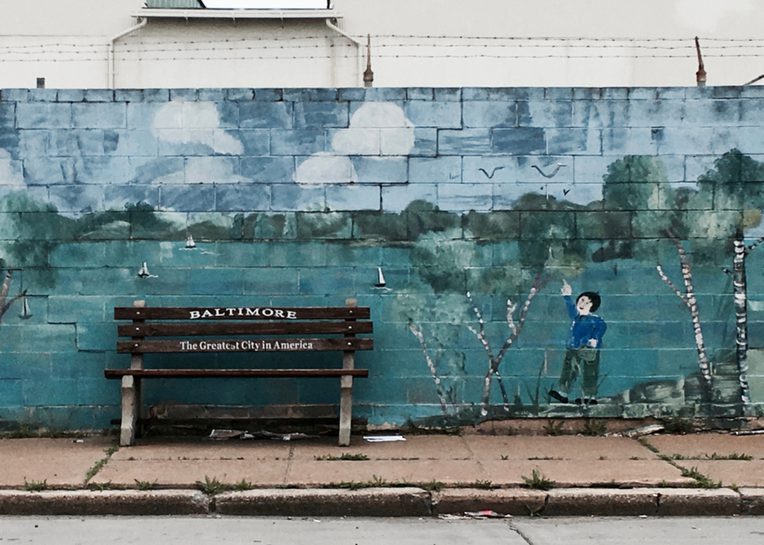Curtis on the Bay: Failed Development and the Mythology of Trump
From the Series: Crisis of Liberalism
From the Series: Crisis of Liberalism

There’s a mythology around Donald Trump in late industrial Baltimore. Angel, a thirty-six-year-old white woman, was the first to bring it up. As we sat on her concrete stoop in the disintegrating town of Curtis Bay last March, overlooking the mountain of coal that commandeers the sky, she kicked a can and said:
When we were teenagers, we used to sit here all the time and talk about how Donald Trump was supposed to take over our neighborhood. It was some kind of rumor. He was supposed to tear down all the factories and build up condos on the water. So for many years—and I still hear it—people have said he’s going to build up Curtis Bay. And we were going to become Curtis on the Bay. Did [my aunt] Norma ever tell you about that? We’ve definitely all had serious conversations about it many times, just sitting out here imagining what the bay was going to look like. We were finally going to become a part of the [inner] harbor—our community was going to be, like, fancy.1
Curtis Bay hasn’t been “fancy” for some time. Once a thriving waterfront hamlet where Baltimore’s elite traveled to escape the vicissitudes of city life, today the town feels like an uneasy remainder—one of many spaces struggling to exist in a system that has spit the American working class out of a good life many believe their sacrifice created. In Curtis Bay, there are at least two hundred years of precedent for this claim, capped by four decades of infrastructural deterioration and the telltale signs of urban disinvestment. For five generations, Curtis Bay has been marked by what some call “failed development,” development that promotes the prosperity of profiteers at local citizens’ expense.


“It’s like a can being crushed, living here,” twenty-six-year-old Scooter explained.
Over the six years that I have worked in Curtis Bay, where I study responses (like this one) to the area’s environmental degradation, I’ve become acquainted with the profound feeling of neglect harbored by the region’s mostly white working-class residents. It often manifests in pessimistic statements about the problems in their long “forgotten” neighborhood, and in accusations that target their black (“freeloader”), immigrant (“illegal”), and religiously marked (“raghead”) neighbors. And on November 8, for many citizens, it manifested in a vote to make the country “great again”—not a vote for Trump, but against an existential stagnation.

“We’re tired of working hard and being shit on,” fifty-four-year-old Charlie maintained.
Before the election and since, columnists have waxed at length about the desperation bound up with a vote for Donald Trump. They have explained that electing a frighteningly temperamental, outrageously inexperienced, unabashedly bigoted multibillionaire to represent the needs of the working class reflects either a political grasping at straws—a calculation that things can’t possibly get worse—or else a pervasive contentment with ignorance.2 George Packer puts it this way:
[Trump’s core voters] have no foundation to stand on; they’re unorganized, unheard, unspoken for. They sink alone. . . . They are not trying to restore stability or preserve the status quo. Rather, they are driven by a sense of violent opposition: against changes in color and culture that appear to be sweeping away the country they once knew. . . . This is the meaning of Trump’s slogan, “Make America Great Again.” Though the phrase invoked nostalgia for an imagined past, it had nothing to do with tradition. It was a call to sweep away the ruling order.
Indeed, the consensus seems to be that Trump supporters bought into a nihilistic perversion of Barack Obama’s calls for hope and change. Drain the swamp. Kick them out. Burn it down.
This theory isn’t wrong; it’s just incomplete. It ignores the “build it up”—however vague—implicit in a “burn it down” mentality. What the mythology of Trump forces us to reckon with is that, sometimes, disaffection expresses itself through fantasy, through development dreams, and through thinly gilded legends of an economic savior.3 In this light, Curtis on the Bay is an artifact of the uncomfortable idea that a vote for Trump might instead have been an act of radical optimism.4
In the months leading up to the presidential election, I heard about Curtis on the Bay on six separate occasions from people who ran in different circles; there was a sort of mythological revival. It wasn’t expectant talk. As far as I could tell, people stopped believing the rumor a long time ago. No, it was talk that claimed to know something that I didn’t get about the Trump mystique, something that I didn’t instinctually sense about the moment’s latent potential. It was talk about deconstructing the conditions of local estrangement (tear down all the factories, they don’t employ us anyway) and folding residents into a prosperity that hadn’t yet embraced them (we were finally going to become a part). But it didn’t engage with the possibility that such a development might complete their own displacement.
Curtis on the Bay is an origin myth—a tale of beginning and creation. It’s just ambivalent about what it hopes to originate.
“What would have happened to the people who live here if they’d built it,” I asked Angel.
“I have no clue,” she admitted. “I don’t think that was part of the dream when somebody drew the picture. And honestly, I doubt Donald Trump is going to save the day.”
“But you never know,” she added, staring at the coal. “I wouldn’t mind if someone came and cleaned up Curtis Bay. And what have we got to lose, anyway?”
1. I looked. I don’t know where the rumor came from, but there’s no documentary evidence that Trump ever pursued development in or near Curtis Bay.
2. This calculation ignores the fact that things can indeed get worse for nonwhite, noncisgender, non-Christian citizens (as well as noncitizens, of course).
3. My figuration of development dreams draws on James Ferguson’s (1999) “expectations of modernity,” those forward-looking, often fanciful visions of developmental revival that respond to conditions of decline.
4. This optimism is almost certainly a “cruel” one, in Lauren Berlant’s (2011) formulation—an instance when the object of one’s desire is at the same time an obstacle to one’s flourishing.
Berlant, Lauren. 2011. Cruel Optimism. Durham, N.C.: Duke University Press.
Ferguson, James. 1999. Expectations of Modernity: Myths and Meanings of Urban Life on the Zambian Copperbelt. Berkeley: University of California Press.